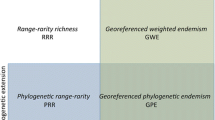Abstract
Two approaches to formulating the reserve site selection problem when species occurrence data is probabilistic were solved for terrestrial vertebrates in a small set of potential reserve sites in Oregon. The expected coverage approach, which maximizes the sum of the occurrence probabilities, yielded solutions that covered more species on average in Monte Carlo simulations than the threshold approach, which maximizes the number of species for which the occurrence probability exceeds some threshold.
Similar content being viewed by others
References
R.F. Noss and A.Y. Cooperrider, Saving Nature's Legacy (Island Press, Washington, DC, 1994).
S.L. Pimm and J.H. Lawton, Planning for biodiversity, Science 279 (1998) 2068–2069.
R.L. Church and C.S. ReVelle, The maximal covering location problem, Papers of the Regional Science Association 32 (1974) 101–118.
R.L. Church, D.M. Stoms and F.W. Davis, Reserve selection as a maximal coverage location problem, Biological Conservation 76 (1996) 105–112.
A.R. Kiester, J.M. Scott, B. Csuti, R.F. Noss, B. Butterfield, K. Sahr and D. White, Conservation prioritization using GAP data, Conservation Biology 10(5) (1996) 1332–1342.
B. Csuti, S. Polasky, P.H. Williams, R.L. Pressey, J.D. Camm, M. Kershaw, A.R. Kiester, B. Downs, R. Hamilton, M. Huso and K. Sahr, A comparison of reserve selection algorithms using data on terrestrial vertebrates in Oregon, Biological Conservation 80 (1997) 83–97.
R.L. Pressey, H.P. Possingham and J.R. Day, Effectiveness of alternative heuristic algorithms for identifying minimum requirements for conservation reserves, Biological Conservation 80 (1997) 207–219.
A. Ando, J. Camm, S. Polasky and A. Solow, Species distributions, land values, and efficient conservation, Science 279 (1998) 2126–2128.
M.P. Austin, R.B. Cunningham and R.M. Fleming, New approaches to direct gradient analysis using environmental scalars and statistical curve-fitting procedures, Vegetatio 55 (1984) 11–27.
C.R. Margules and A.O. Nicholls, Assessing the conservation value of remnant habitat “islands”: mallee patches on the western Eyre Peninsula, South Australia, in: Nature Conservation: The Role of Remnants of Native Vegetation, eds. D.A. Saunders, G.W. Arnold, A.A. Burbidge and A.J.M. Hopkins (Surrey Beatty and Sons, Sydney, 1987) pp. 89–102.
C.R. Margules and J.L. Stein, Patterns in the distribution of species and the selection of nature reserves: an example from Eucalyptus forests in South-Eastern New South Wales, Biological Conservation 50 (1989) 219–238.
A.O. Nicholls, How to make biological surveys go further with generalized linear models, Biological Conservation 50 (1989) 51–75.
C.R. Margules and M.P. Austin, Biological models for monitoring species decline: the construction and use of data bases, Philosophical Transactions of the Royal Society of London Biological Sciences 345 (1994) 69–75.
S. Polasky, J.D. Camm, A.R. Solow, B. Csuti, D. White and R. Ding, Choosing reserve networks with incomplete species information, Biological Conservation 94 (2000) 1–10.
J.D. Camm, S.K. Norman, S. Polasky and A. Solow, Nature reserve selection to maximize expected species covered, Operations Research (2001), in press.
M.S. Daskin, A maximum expected covering location model: formulation, properties and heuristic solution, Transportation Science 17 (1983) 48–70.
M.S. Daskin, K. Hogan and C.S. ReVelle, Integration of multiple, excess, backup and expected covering models, Environment and Planning B 15 (1988) 15–35.
C.-M. Liu and A.-H. Wang, Solving location-allocation problems with rectilinear distances by simulated annealing, Journal of the Operational Research Society 45 (1994) 1304–1315.
A.T. Murray and R.L. Church, Applying simulated annealing to location-planning models, Journal of Heuristics 2 (1996) 31–53.
G. Righini, Annealing algorithms for multisource absolute location problems on graphs, Computational Optimization and Applications 7 (1997) 325–337.
A.T. Ernst and M. Krishnamoorthy, Solution algorithms for the capacitated single allocation hub location problem, Annals of Operations Research 86 (1999) 141–159.
C.M. Hosage and M.F. Goodchild, Discrete space location-allocation solutions from genetic algorithms, Annals of Operations Research 6 (1986) 35–46.
C.R. Houck, J.A. Joines and M.G. Kay, Comparison of genetic algorithms, random restart and two-opt switching for solving large location-allocation problems, Computers & Operations Research 23 (1996) 587–596.
A. Kumar, Y. Gupta, M. Gupta and C. Sundaram, A genetic algorithmbased approach to cell composition and layout design problems, International Journal of Production Research 34 (1996) 447–482.
F.A.W. George, Hybrid genetic algorithms with immunisation to optimise networks of retail outlets, Studies in Locational Analysis 8 (1996) 59–80.
T.G. Crainic, M. Toulouse and M. Gendreau, Synchronous tabu search parallelization strategies for multicommodity location-allocation with balancing requirements, Operations Research Spektrum 17 (1995) 113–123.
E. Rolland, D.A. Schilling and J.R. Current, An efficient tabu search procedure for the p-median problem, European Journal of Operational Research 96 (1997) 329–342.
M. Ohlemuller, Tabu search for large location-allocation problems, Journal of the Operational Research Society 48 (1997) 745–750.
B. Gendron, J.-Y. Potvin and P. Soriano, Tabu search with exact neighbour evaluation for multicommodity location with balancing requirements, INFOR 37 (1999) 255–270.
R.G. Haight, C.S. ReVelle and S.A. Snyder, An integer optimization approach to the probabilistic reserve site selection problem, Operations Research 48(5) (2000) 697–708.
S.V. Ciriacy-Wantrup, Resource Conservation: Economics and Policies, 3rd ed. (University of California Press, Berkeley, CA, 1968).
R.C. Bishop, Endangered species and uncertainty: the economics of the safe minimum standard, American Journal of Agricultural Economics 60 (1978) 10–18.
L. Master, N. Clupper, E. Gaines, C. Bogert, R. Solomon and M. Ormes, Biodiversity Research Consortium Species Database Manual (The Nature Conservancy, Boston, MA, 1995).
A.M. Law and W.D. Kelton, Simulation Modeling and Analysis (McGraw-Hill, New York, 1982).
S. Polasky, J.D. Camm and B. Garber-Yonts, Selecting biological reserves cost effectively: an application to terrestrial vertebrate conservation in Oregon, Land Economics 77(1) (2001) 68–78.
Author information
Authors and Affiliations
Rights and permissions
About this article
Cite this article
Arthur, J.L., Haight, R.G., Montgomery, C.A. et al. Analysis of the Threshold and Expected Coverage Approaches to the Probabilistic Reserve Site Selection Problem. Environmental Modeling & Assessment 7, 81–89 (2002). https://doi.org/10.1023/A:1015693531132
Issue Date:
DOI: https://doi.org/10.1023/A:1015693531132




